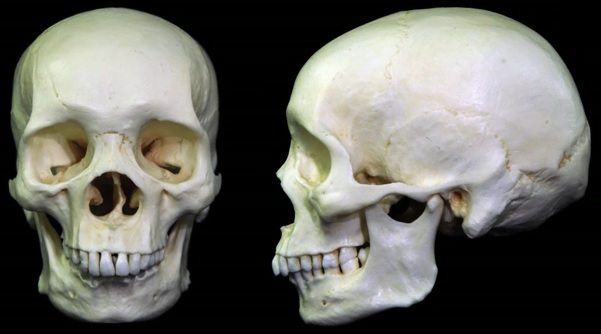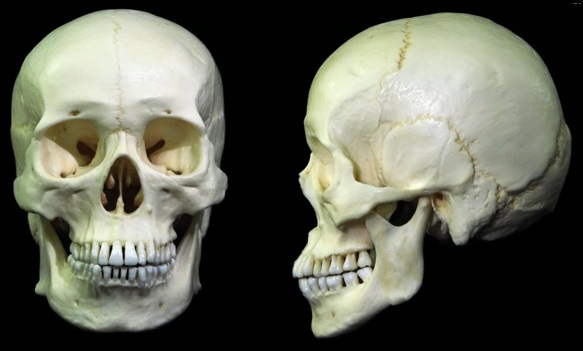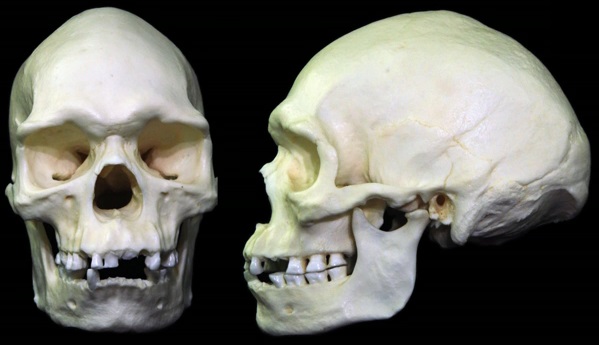Please feel free to comment on what you thought of the blog, or other physical anthropological subjects you would like me to cover.
|
When you look at a person, you can get an idea of where they're from by the look of their skin, their eyes, even of their hair. But what happens when their skin is gone, could you still? From the skulls that are in the media, it seems safe to say that all male skulls are the same along with female skulls. Now, if you remember from my blog titled “Week 5” (http://anthropologicalconcepts.weebly.com/blog/week-5), the appearance of the skull can have lots to do how your outer face can look like. In this weeks blog I will discuss how each ethnicity or ancestry's have very different skulls. “The groups are African, European, Asian, and Oceanic. This is an imperfect classification system, but it is useful in the broad base of assigning identity to an individual.” I will be using terms that might be unfamiliar to you, so below I have included a photo marked with the areas I will address. Below we have a photo of an African skull. African refers to individuals descendant from Saharan and sub-Saharan Africa. From the side the noticable African acestry is marked by a long crainal shape, and moderate to strong prognathism. Also from the side, they have a flat anterior nasal spine and a “Quonset-hut like nasal root morphology, which means that it is almost semi circular in cross section.” From the front you can see they have rectangular orbits and a wide inter-orbiral distance, along with a broad nasal aperture. In addition to these that you can see from the side and from the front, there is one that you can notice from both views; the brow ridges. They have a “mild to moderate development of the brow ridges with a moderate glabella.” Next we have European (image below). European refers to individuals descendant from the European continent, the Indian subcontinent, North Africa, and the Middle East. For European ancesty they have a rounded cranial shape. You can immediately notice that they have a prominent nose from how far their nasal root is (this type of nasal root is usually called “steepled.”). Other features of the nose is their nasal aperture is narrow, and the anterior nasal spine is prominent along with the chin. The front shows they have angular orbits, and a narrow inter-orbital distance. For the brow ridges and glabella, they would have moderate to strong brow ridges, but with a depressed glabella. With the Asian skull (image below), which refers to individuals descendant from Central or East Asia, First Nation Americans, Inuits and some groups in East Russia, it looks very similar to the European because of the rounded cranial shape, but they could not be more different. The face is wider and the major difference, I think, is in the nose. Unlike the European steepled nose, Asian ancesty has a tented nasal root, with a flat anterior nasal spine, and a moderate nasal aperture. For the eyes, they are classified as having a round orbital shape with a moderate inter-orbital distance. And unlike both the African and European ancestry, the Asian ancestry has a “faint or absent brow ridges and a moderately prominent glabella.” Lastly we have a skull of Oceanic ancestry (image below). Oceanic refers to individuals descendant from First Nation inhabitants of the South Pacific Islands, New Zealand, and Australia. This skull looks nothing like the other ones, so it could not be mistaken for African, European, or Asian ancesty. They have a high and short cranial shape with a mild to moderate. The nasal root looks similar to that of European as it is steepled, but the anterior nasal spine is flat, like the African, and a moderate nasal aperture, like the Asian. Now with the eyes, they have a rectangular orbit shape with a wide inter-orbital distance. And unlike the skulls I addressed earlier, those of Oceanic ancestry will most likely have a well-developed brow ridges with a prominent glabella, and finally, “a rocker bottom jaw with a rounded mandibular margin.” Now that you have seen how much ancestry can take effect with, not only on how our families does things, but also how we look, is it not silly to have believed that the only difference lies in if we are male or female. I have to admit, I was amoung the silly. It is lucky that physical/forensic anthropologists have made the distinctions because who knows how much we have traveled to difference places, and if a skeleton with Asian ancestry is found in Africa, it can be assumed that they were a tourist or the like.
Please feel free to comment on what you thought of the blog, or other physical anthropological subjects you would like me to cover.
5 Comments
anna
11/23/2017 06:27:49 pm
Thanks. Very interesting to see the different skulls. We can easily forget that these differences exist when always handling the same skull.
Reply
Ed Kuijper
1/20/2018 05:00:28 am
When you observing en study the shapes of the head of people around you, you will see that there a lot of differences. A few times i have seen people in a crowd which had brow ridges and sloping forheads like a neanderthal. Once i saw a man that had a forehead like homo erectus. One example is the famous boxer Nicolai Valuev
Reply
Baboon
6/29/2018 01:25:50 am
Valuev suffers from acromegaly.
Reply
Steven lin
10/5/2018 09:03:10 pm
Neanderthals were wiped out and only Homo sapiens survived, which reproduce and last until today, creating all of us.
Reply
Baboon
6/29/2018 12:32:24 am
The problem with you page here is that you are basing entire people on single skulls. Also you even made mistakes within the skulls just on here.
Reply
Leave a Reply. |
AuthorA recently made anthropologist who has been set loose to study the humans of the then, today, what's to come, and beyond. Archives
September 2016
Categories |





 RSS Feed
RSS Feed
